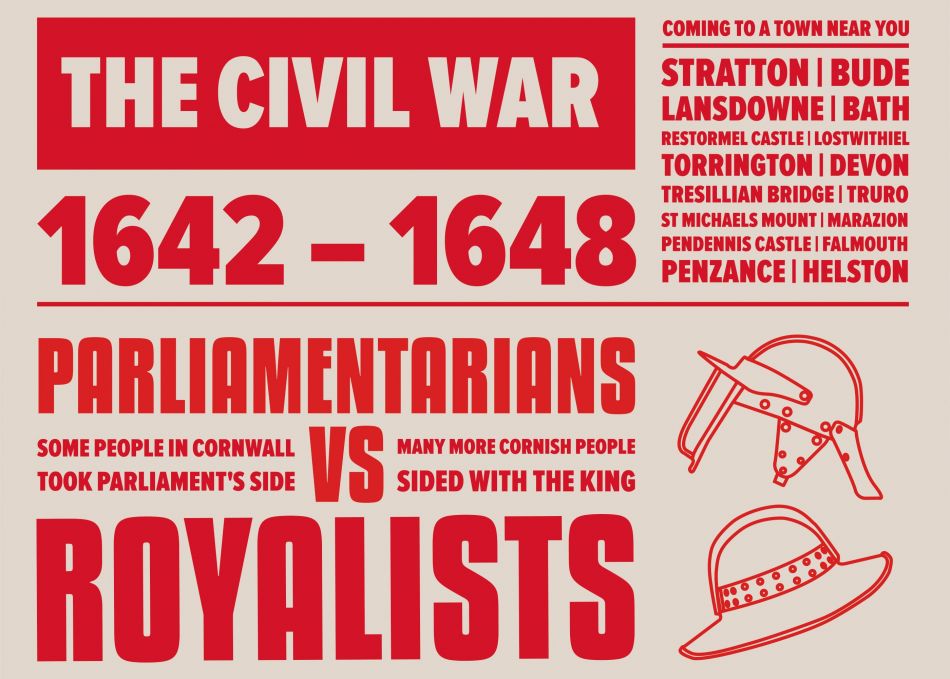Cornwall stood alone
When the Civil War began in 1642, people in Cornwall formed a Royalist army to support King Charles I. However, most people in the counties of southwest England supported the Parliamentary army. In May 1643, the Parliamentarians saw a chance to ‘invade’ and take control of Cornwall, with an army led by the Earl of Stamford. Their army was twice as large as the Cornish Royalists and had more money, food and gunpowder.
Cornwall invaded
The Cornish Royalist army defended Cornwall’s border by placing soldiers all along the River Tamar. The only weak point was the crossing between Holsworthy in Devon and Stratton in north Cornwall. On 11th May 1643, the Parliamentarian army entered Cornwall at this point and camped on a high hill in Stratton. They had 5,400 soldiers and 13 cannons. However, most of their cavalry (soldiers on horses) were sent to Bodmin.
Tired and hungry
The Cornish Royalist army soon learned that the Parliamentarians had invaded Cornwall. The Cornish leaders decided that they must attack the Parliamentarians at Stratton before their cavalry arrived from Bodmin. The Cornish soldiers, led by Sir Ralph Hopton, left Launceston to march to Stratton. This took two days and the soldiers only had one biscuit each to eat. They were cold, tired and hungry when they reached Bude, near Stratton, and camped on Summerleaze Downs.
The battle begins
The Cornish Royalist army had about 2,400 soldiers and 500 cavalry. At dawn on 16th May 1643, the two sides began to fire their muskets (guns) at each other. The Cornish Royalist army formed into four groups to attack the Parliamentarian army on the hill in Stratton. Each group attacked from a different direction. These attacks continued into the afternoon. Some Cornish soldiers with pikes (long wooden poles with pointed metal ends) charged up the hill and others fired their muskets. However, the Parliamentarians could not be moved from the hilltop.
The final charge
By 3pm, the Cornish soldiers had run out of bullets and gunpowder. Their only option was to charge up the hill one last time, with just their pikes and swords. During this attack the Cornish leader Sir Bevil Grenville was knocked to the ground but he managed to get up and continue fighting. The sight of the Cornishmen silently coming up the hill from four directions caused the Parliamentarian army to panic and run from the battlefield. All four groups of the Cornish Royalist army met at the top of the hill – they had won the battle against all the odds!
Imagine that you have marched for 20 miles. You’ve had no sleep and only eaten one biscuit in two days. Now you have to fight for your life in a battle up a steep hill for 12 hours. The Cornish soldiers must have been very strong, very fit and determined to protect Cornwall from invasion.
Cornwall secured for the king
The Cornish Royalist army captured 1,700 Parliamentarian prisoners, 70 barrels of gunpowder, 13 cannons, food rations and £5,000. During the battle, 300 Parliamentarian soldiers were killed. The Cornish soldiers had fought so bravely that the Parliamentarian army leader Major General James Chudleigh changed sides to join them.
The victory of the Cornish soldiers at Stratton was a turning point in the Civil War. It pushed the Parliamentarian army out of Cornwall and secured it for the king. It also allowed the Cornish Royalist army to break out of Cornwall and fight the Parliamentarians in the south of England.
Did you know?
The Cornish people fought so bravely that King Charles sent a letter thanking them for their support. The letter was displayed in every church in Cornwall. Many churches still have a copy of the letter on display today.
Antony Payne, known as the ‘Cornish Giant’, lived at the Tree Inn in Stratton. He probably fought in the Cornish Royalist army at the Battle of Stratton. He was over two metres tall, and his portrait can be seen in the Royal Cornwall Museum.
Even though the Earl of Stamford lost the Battle of Stratton, the hill where it took place is now known as Stamford Hill.








